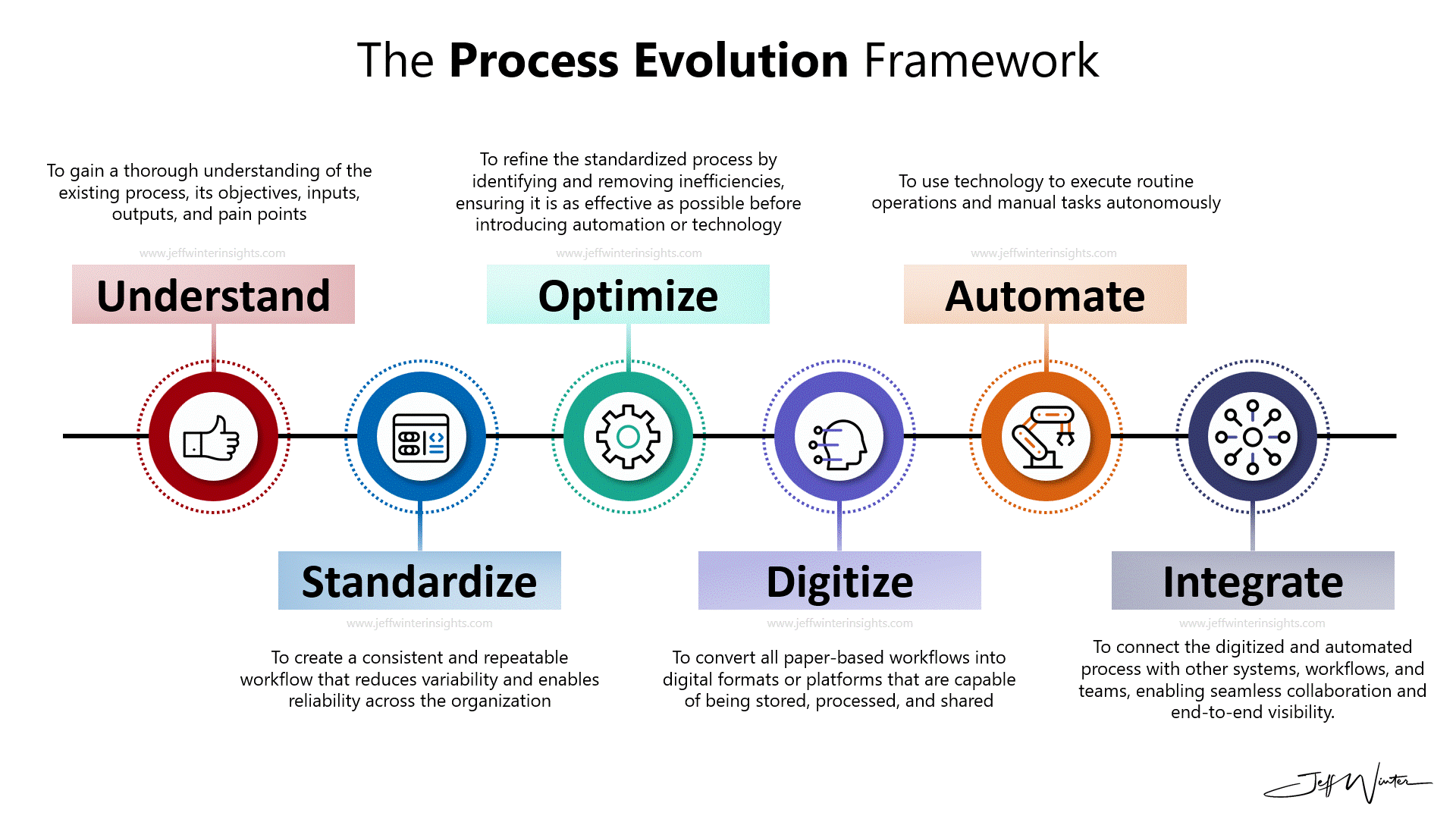The Process Evolution Framework
Businesses are under pressure to streamline operations, cut costs, and stay ahead of the competition. But too often, they leap straight into the "solution"—automating tasks or implementing the latest technologies—without understanding the underlying processes they aim to improve. This is where the Process Evolution Framework comes in.
Why This Framework Exists
Many organizations fall into the trap of jumping straight to automation, hoping it will solve inefficiencies and streamline operations. While automation is powerful, it is only as good as the process it’s applied to. Without proper groundwork, automation often amplifies flaws instead of fixing them.
By following this step-by-step approach, businesses can ensure that their processes are not just faster or more advanced but fundamentally better.
The Process Evolution Framework is more than a sequence of steps—it’s a philosophy that prioritizes thoughtful, incremental improvement over quick fixes. This framework isn’t about rigid rules—it’s a guide. While some steps can be skipped, doing so increases the risk of poor outcomes, such as inefficiencies, bottlenecks, and costly rework.
1. Understand
Understanding the current process is the foundation for meaningful change. This step involves deeply analyzing the workflow to uncover inefficiencies, bottlenecks, and opportunities for improvement. It’s not just about identifying problems but also recognizing what works well.
Key considerations:
Map out the process in detail to understand every step and decision point.
Gather input from employees who work with the process daily to uncover hidden pain points and insights.
Use data to back up observations—track metrics like cycle times, error rates, or costs.
Focus on identifying the root causes of inefficiencies, not just the symptoms.
Evaluate how the process aligns with broader organizational goals and priorities.
2. Standardize
Standardization ensures consistency and reliability by creating a repeatable process that reduces variability. This step establishes a baseline that enables scalability and prepares the process for optimization and digitization.
Key considerations:
Document every step of the process, clearly defining roles, responsibilities, and expectations.
Ensure all stakeholders understand and adhere to the standardized process through training and communication.
Focus on creating a single, unified way of performing the process, eliminating unnecessary deviations.
Identify best practices already being used by high-performing teams and scale them organization-wide.
Build in flexibility where appropriate to accommodate unique situations without undermining consistency.
3. Optimize
Optimization focuses on refining the standardized process to maximize efficiency and effectiveness. This step is about removing waste, streamlining workflows, and ensuring the process operates as smoothly as possible.
Key considerations:
Analyze the standardized process to identify areas of waste, inefficiency, or redundancy.
Involve employees in brainstorming and testing solutions for streamlining workflows.
Leverage Lean principles, such as the 8 wastes, to systematically evaluate and improve the process.
Use data to measure the impact of changes, ensuring optimizations result in tangible improvements.
Avoid over-optimization that sacrifices quality or creates unnecessary complexity.
4. Digitize
Digitization converts manual or paper-based workflows into digital systems, enabling easier data storage, retrieval, and sharing. This step enhances visibility and lays the foundation for automation by enabling data-driven decision-making.
Key considerations:
Assess what data needs to be captured digitally and how it will be used to improve decision-making.
Choose digital tools or platforms that align with the organization’s existing systems and long-term strategy.
Pilot digital solutions on a smaller scale to identify potential challenges before full implementation.
Ensure employees are trained to use the new digital systems effectively, addressing any resistance to change.
Regularly review and update digital workflows to keep them aligned with evolving business needs.
5. Automate
Automation uses technology to execute repetitive tasks, reducing manual effort and freeing up employees for higher-value work. This step builds on the digitized process, taking efficiency to the next level by eliminating routine human intervention.
Key considerations:
Identify tasks that are repetitive, time-consuming, and have clearly defined rules—these are ideal for automation.
Focus on automating areas with the highest potential for impact, such as reducing errors or speeding up turnaround times.
Monitor automated processes to ensure they perform as expected and deliver measurable benefits.
Start small, automating one area at a time, and scale gradually as you gain confidence and experience.
Communicate the purpose and benefits of automation to employees to alleviate concerns about job displacement.
6. Integrate
Integration ensures the automated process is seamlessly connected with other systems, workflows, and teams across the organization. This step transforms isolated improvements into part of a cohesive, interconnected ecosystem.
Key considerations:
Ensure data flows smoothly between systems, eliminating silos and enabling end-to-end visibility.
Build cross-functional teams to oversee integration efforts and identify potential challenges early.
Focus on creating a unified platform where all stakeholders can access and act on shared information.
Use APIs or middleware solutions to connect legacy systems with modern tools, minimizing disruption.
Regularly assess and refine integrations to ensure they remain aligned with business goals and evolving technologies.

